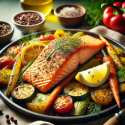
Our product evaluations are completely independent and free from advertisements. Should you make a purchase via the links on our website, we might receive a small commission, which is a key support for our review process. For more details, click here.
Introduction
With the increasing popularity of plant-based diets, many people are exploring ways to improve their health without eliminating entire food groups. The Flexitarian Diet offers a balanced, flexible approach to healthier eating. It promotes primarily plant-based foods while allowing for occasional meat and animal products, providing both health benefits and freedom from the restrictions of traditional diets.
In this article, we’ll dive deep into what the Flexitarian Diet is all about, discuss its benefits and challenges, provide practical meal plan ideas, and answer common questions to help you decide if it’s the right diet for you.
What is the Flexitarian Diet?
The Flexitarian Diet, a combination of “flexible” and “vegetarian,” was created by dietitian Dawn Jackson Blatner. This diet emphasizes a predominantly vegetarian approach but doesn’t exclude animal products entirely, allowing you the flexibility to consume meat, fish, and dairy occasionally. This makes it a more adaptable lifestyle choice than other plant-based diets.
Key Principles of the Flexitarian Diet
- Prioritize Plant-Based Foods: The diet is largely plant-centered, meaning that fruits, vegetables, whole grains, and legumes form the backbone of your meals.
- Limit, Don’t Eliminate Meat: While it encourages reducing meat intake, it doesn’t require you to cut out meat completely, giving you the freedom to indulge moderately.
- Gradual Transitioning: Start small by introducing a few plant-based meals each week. As you grow more comfortable, increase the frequency of these meals until you reach a balance that suits you.
- Emphasis on Whole Foods: Minimize processed foods and focus on natural, nutrient-dense foods to fuel your body.
What to Eat on the Flexitarian Diet

- Vegetables: Aim to include a colorful range, from leafy greens (like spinach and kale) to starchy vegetables (like sweet potatoes and squash).
- Fruits: Enjoy a variety, such as berries, apples, citrus fruits, and tropical options like mangoes and pineapples.
- Whole Grains: Choose fiber-rich grains like brown rice, quinoa, barley, farro, oats, and whole-wheat pasta.
- Plant-Based Proteins: Legumes (like lentils, beans, and chickpeas), tofu, tempeh, nuts, and seeds are essential sources of protein.
- Animal-Based Proteins (Occasionally): If desired, include lean meats like chicken, turkey, eggs, and fish, aiming to prioritize quality sources. Read about High Protein diet here.
- Healthy Fats: Avocados, olive oil, nuts (such as almonds and walnuts), seeds (like chia and flax), and fatty fish (like salmon) for those who consume seafood.
- Dairy: Yogurt, milk, and cheese can be included in moderation, or you can opt for plant-based alternatives like almond or soy milk.
Foods to Limit on the Flexitarian Diet
- Processed Meats: Such as bacon, sausage, and other highly processed meats.
- Sugary Foods: Limit candies, pastries, sugary cereals, and other refined sugar sources.
- Refined Grains: Avoid white bread, white rice, and refined pasta; instead, focus on whole-grain alternatives.
- Highly Processed Snacks: Chips, cookies, and packaged snack foods generally add little nutritional value and can be calorie-dense.
Flexitarian Diet Week Long Meal Plan Example
To give you an idea of what a typical week on the Flexitarian Diet might look like, here’s a sample meal plan that combines a variety of foods and flavors. This example includes entirely plant-based meals alongside those that feature moderate amounts of animal products.
Monday
- Breakfast: Smoothie bowl with spinach, frozen berries, banana, almond milk, and topped with chia seeds.
- Lunch: Quinoa salad with mixed greens, chickpeas, cucumber, tomatoes, and a lemon-tahini dressing.
- Dinner: Grilled vegetable stir-fry with tofu, broccoli, bell peppers, and a side of brown rice.
Tuesday

- Breakfast: Avocado toast on whole-grain bread topped with cherry tomatoes and pumpkin seeds.
- Lunch: Lentil soup with mixed vegetables and a slice of whole-grain bread.
- Dinner: Grilled salmon served with steamed asparagus, roasted sweet potatoes, and a leafy green salad.
Wednesday
- Breakfast: Oatmeal with almond milk, sliced bananas, walnuts, and a dash of cinnamon.
- Lunch: Black bean tacos with lettuce, tomato, avocado, and a sprinkle of cheese (optional).
- Dinner: Mushroom and spinach risotto made with vegetable broth and nutritional yeast.
Thursday
- Breakfast: Greek yogurt parfait with berries, granola, and honey.
- Lunch: Veggie burger on a whole-wheat bun with lettuce, tomato, and a side of roasted sweet potato wedges.
- Dinner: Vegetable pasta with marinara sauce, roasted zucchini, mushrooms, and basil.
Friday
- Breakfast: Scrambled eggs with sautéed vegetables and a slice of whole-grain toast.
- Lunch: Falafel wrap with mixed greens, hummus, cucumber, and a yogurt-based sauce.
- Dinner: Baked chicken breast with mashed cauliflower and steamed green beans.
Saturday
- Breakfast: Chia pudding with almond milk, topped with fresh berries, a sprinkle of granola, and a drizzle of honey.
- Lunch: Marinated tofu and vegetable wrap with hummus, spinach, shredded carrots, and bell peppers in a whole-grain tortilla.
- Dinner: Vegetable curry with chickpeas, spinach, carrots, and coconut milk, served over brown rice.
- Snack: A handful of almonds and a sliced apple.
Sunday

- Breakfast: Veggie-packed omelet with bell peppers, onions, tomatoes, and a side of whole-grain toast.
- Lunch: Mediterranean quinoa bowl with mixed greens, cucumbers, cherry tomatoes, Kalamata olives, feta cheese (optional), and a lemon-olive oil dressing.
- Dinner: Grilled shrimp with a side of roasted Brussels sprouts, sweet potatoes, and a mixed green salad.
- Snack: Fresh fruit salad with melon, grapes, and strawberries.
This flexitarian meal plan offers a variety of textures, flavors, and nutrients, making it satisfying and sustainable.
Delicious Flexitarian Recipes
Enjoy a mix of plant-based and flexible dishes with these easy, tasty recipes. They’re packed with nutrients and perfect for balanced, satisfying meals.
1. Chickpea and Vegetable Buddha Bowl
- Ingredients:
- 1 cup cooked quinoa
- 1/2 cup canned chickpeas, rinsed and drained
- 1/2 avocado, sliced
- 1/2 cucumber, sliced
- Mixed greens (spinach, arugula, etc.)
- 1/2 cup roasted sweet potatoes
- Dressing: Tahini, lemon juice, a pinch of salt, and water to thin
- Instructions:
- Arrange all ingredients in a bowl, placing each one in a separate section.
- Drizzle with tahini dressing and serve fresh.
2. Lentil and Vegetable Stir-Fry with Tofu
- Ingredients:
- 1 cup cooked lentils
- 1/2 block tofu, cubed
- 1 bell pepper, sliced
- 1 zucchini, sliced
- 1/2 onion, diced
- 1 tbsp olive oil
- Soy sauce or tamari for seasoning
- Optional: sprinkle of sesame seeds
- Instructions:
- Heat oil in a pan, then add tofu cubes and cook until golden brown.
- Add vegetables and cook until tender, then add cooked lentils.
- Season with soy sauce and sprinkle with sesame seeds if desired.
3. Baked Salmon with Roasted Vegetables

- Ingredients:
- 1 small salmon fillet
- 1 cup mixed vegetables (e.g., carrots, broccoli, bell peppers)
- 1 tbsp olive oil
- Salt, pepper, and herbs of choice (such as rosemary or thyme)
- Instructions:
- Preheat the oven to 400°F (200°C).
- Place the salmon and vegetables on a baking sheet, drizzle with olive oil, and season.
- Bake for 12-15 minutes until salmon is cooked through and vegetables are tender.
4. Vegetarian Tacos
- Ingredients:
- 1 cup black beans, rinsed and drained
- 1/2 cup corn kernels
- 1 small tomato, diced
- Fresh cilantro, chopped
- 1 avocado, diced
- Tortillas (whole-grain if possible)
- Lime wedges for serving
- Instructions:
- Warm the black beans and corn in a pan.
- Assemble tacos by layering beans, corn, tomatoes, avocado, and cilantro in each tortilla.
- Squeeze fresh lime juice over the top and enjoy.
These recipes showcase the variety of flavors and nutrients you can enjoy on the Flexitarian Diet. Whether you’re in the mood for a fully plant-based meal or one with a bit of fish, there’s something here to satisfy every craving.
* See more Diet Options: Structured Diets | Specific Condition Diet | Fasting Diets
Pros and Cons of the Flexitarian Diet
Pros
- Health Benefits: Studies suggest that reducing meat intake can decrease the risk of chronic diseases like heart disease, high blood pressure, and type 2 diabetes.
- Environmental Impact: Consuming less meat has been shown to reduce greenhouse gas emissions, which is beneficial for the environment.
- Sustainable and Adaptable: The diet’s flexibility makes it easier to maintain over time than restrictive diets.
- Variety and Nutritional Balance: Incorporating both plant-based and animal-based foods in moderation provides a wide range of essential nutrients.
Cons
- Nutrient Deficiencies: Some people may need to supplement or carefully plan for nutrients such as vitamin B12, iron, and omega-3 fatty acids, which are primarily found in animal products.
- Meal Planning Effort: Creating balanced meals may take extra time and planning, especially when reducing meat intake.
- Overindulgence Risk: The flexible nature of the diet can lead to overconsumption of less healthy foods if not balanced properly.
FAQs on the Flexitarian Diet
Conclusion: Embrace Flexibility with the Flexitarian Diet
The Flexitarian Diet offers a healthful, flexible approach to nutrition that fits well into a balanced lifestyle. With its plant-based focus and adaptable nature, it allows for better health without making you give up your favorite foods.
If you’re interested in a sustainable approach to healthier eating, give flexitarianism a try and start exploring delicious, nourishing flexitarian dishes. Remember, small changes can lead to lasting benefits!
